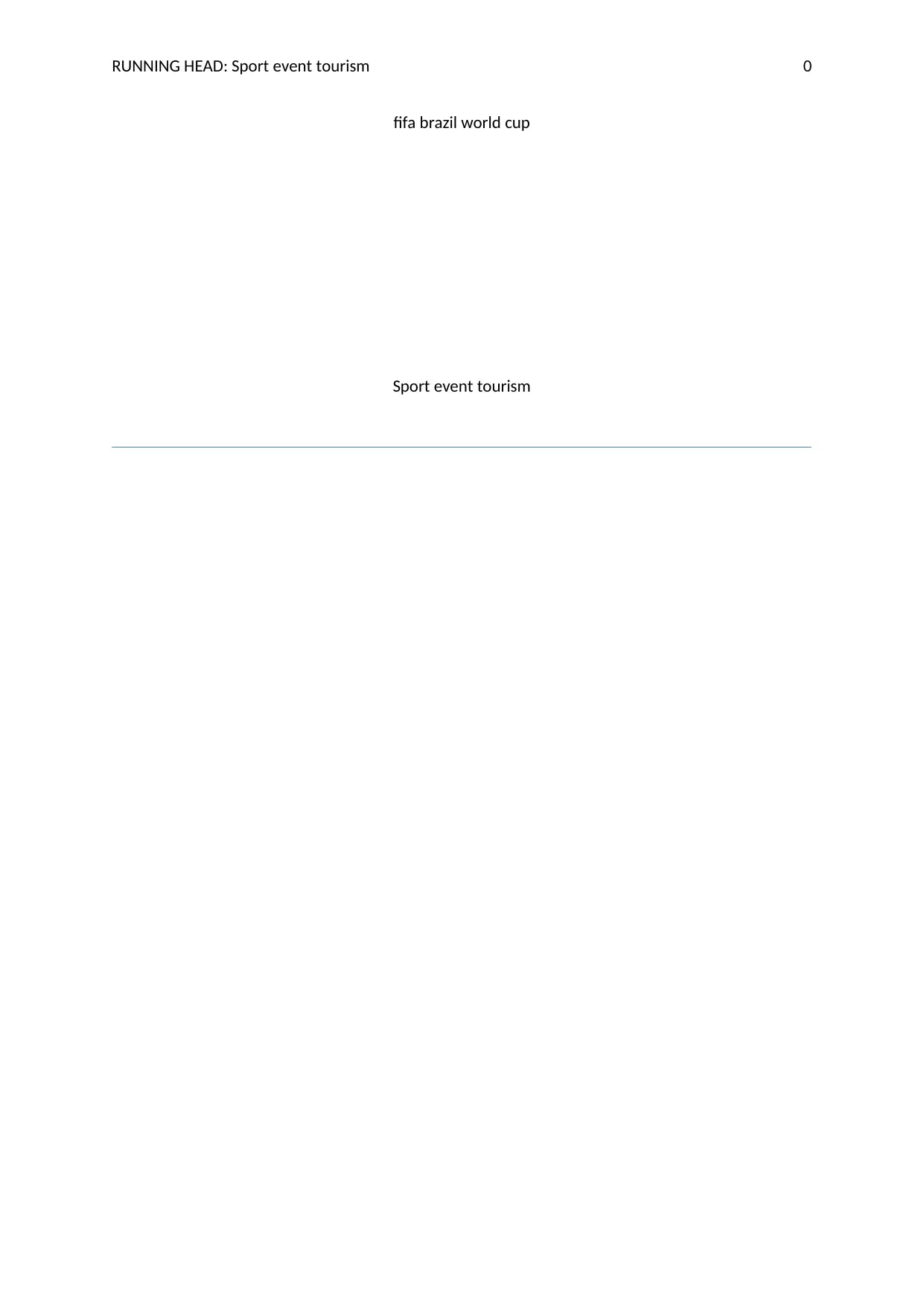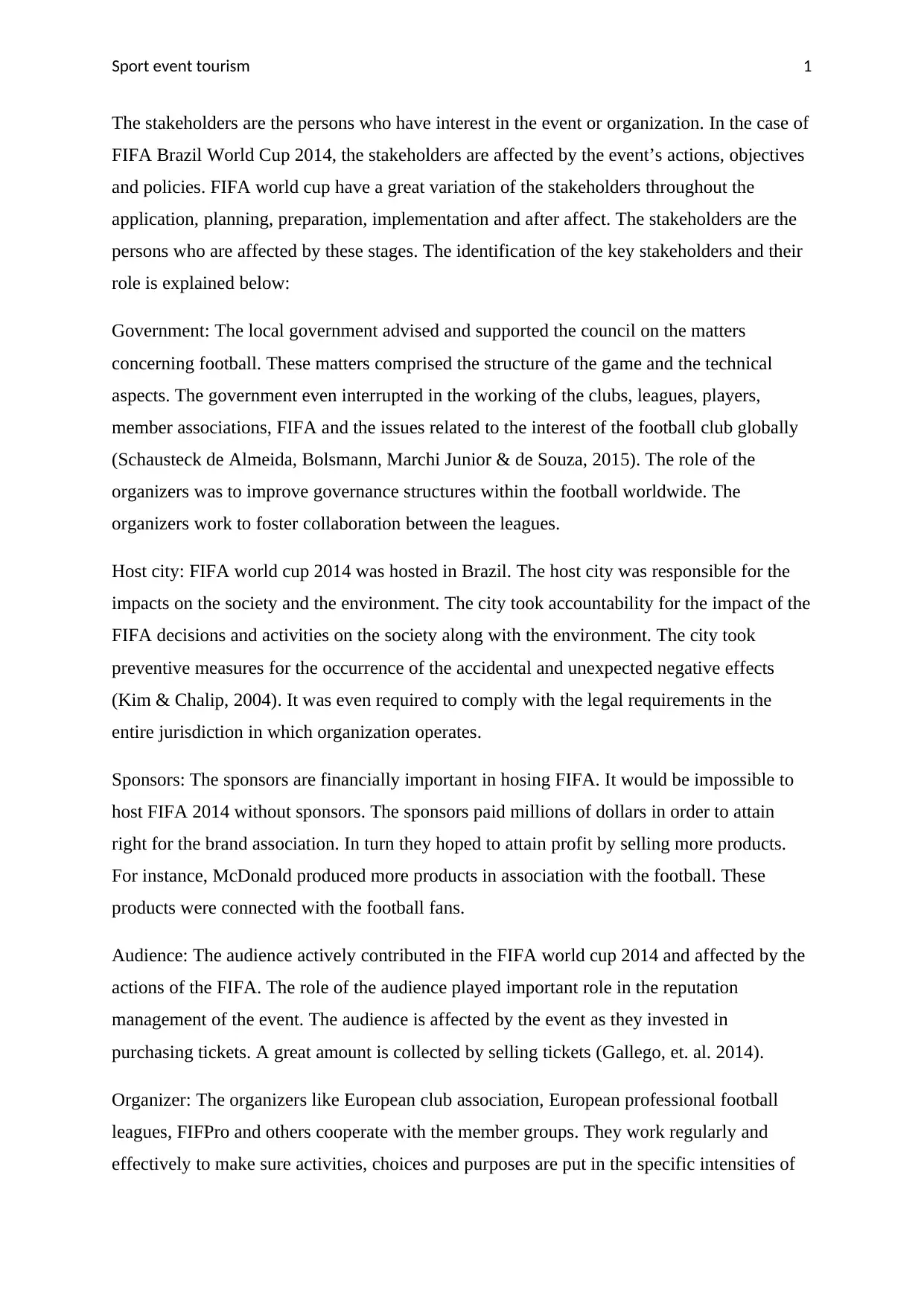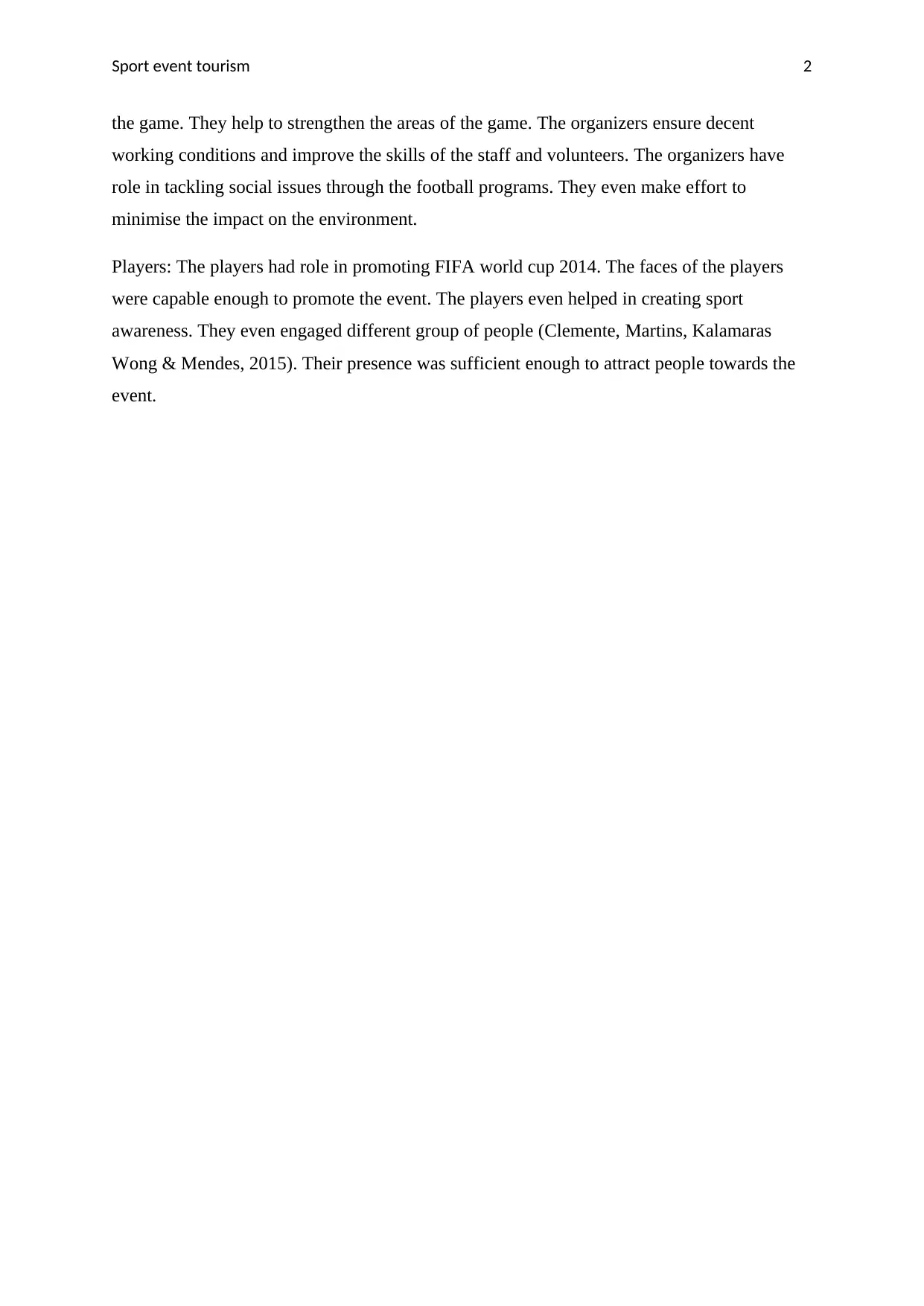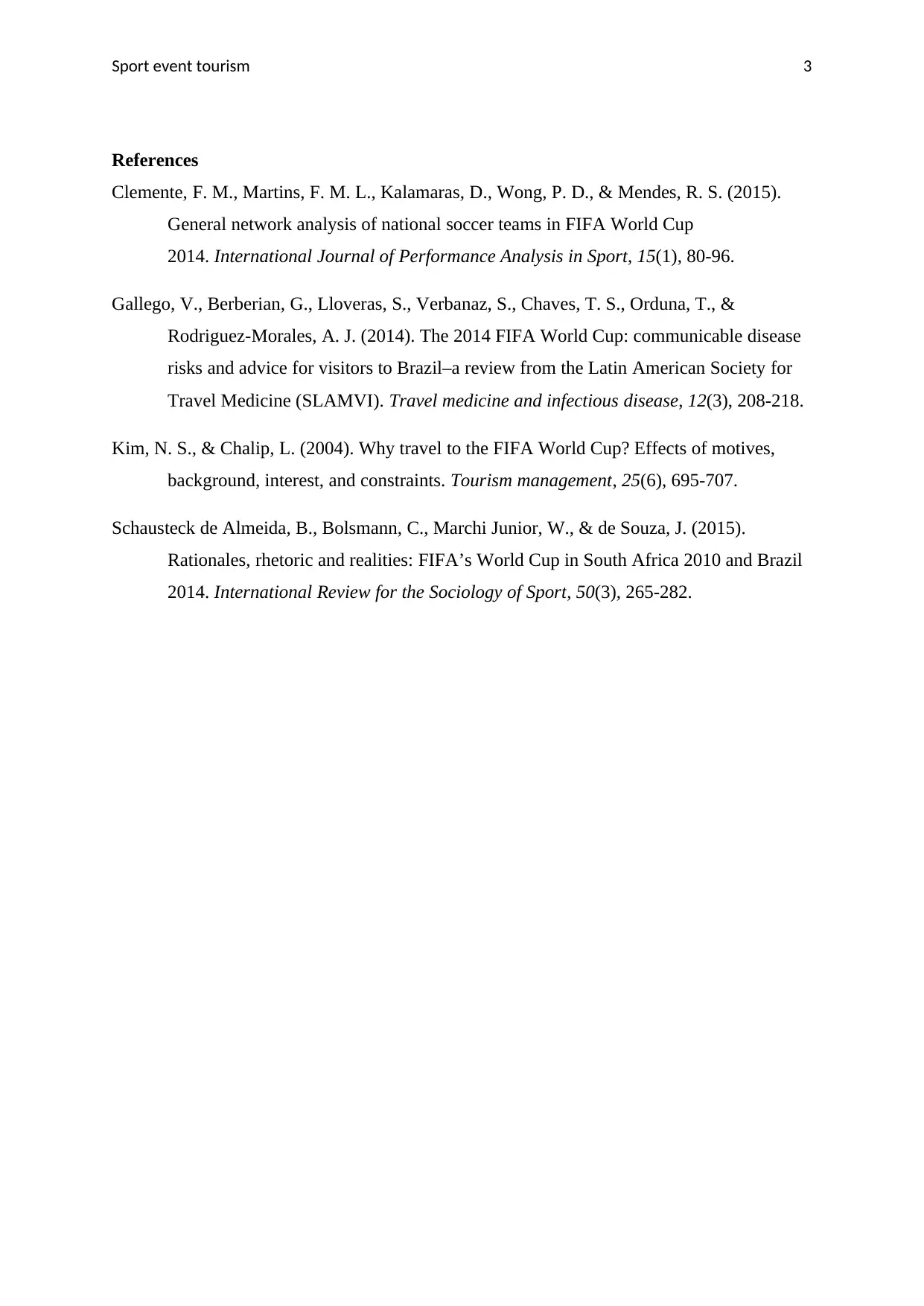Stakeholder Identification and Roles in FIFA Brazil World Cup 2014
VerifiedAdded on 2023/05/28
|4
|842
|375
Essay
AI Summary
This essay identifies and analyzes the key stakeholders involved in the FIFA Brazil World Cup 2014, highlighting their roles and influences throughout the event's various stages, including application, planning, preparation, implementation, and post-event impact. It examines the roles of the government in providing advice and support, the host city's responsibility for societal and environmental impacts, the financial importance of sponsors, the audience's contribution to the event's reputation, the organizers' efforts to strengthen the game, and the players' role in promoting the event and creating sports awareness. The essay provides a comprehensive overview of how these stakeholders interact and contribute to the overall success and impact of the FIFA World Cup.

RUNNING HEAD: Sport event tourism 0
fifa brazil world cup
Sport event tourism
fifa brazil world cup
Sport event tourism
Paraphrase This Document
Need a fresh take? Get an instant paraphrase of this document with our AI Paraphraser

Sport event tourism 1
The stakeholders are the persons who have interest in the event or organization. In the case of
FIFA Brazil World Cup 2014, the stakeholders are affected by the event’s actions, objectives
and policies. FIFA world cup have a great variation of the stakeholders throughout the
application, planning, preparation, implementation and after affect. The stakeholders are the
persons who are affected by these stages. The identification of the key stakeholders and their
role is explained below:
Government: The local government advised and supported the council on the matters
concerning football. These matters comprised the structure of the game and the technical
aspects. The government even interrupted in the working of the clubs, leagues, players,
member associations, FIFA and the issues related to the interest of the football club globally
(Schausteck de Almeida, Bolsmann, Marchi Junior & de Souza, 2015). The role of the
organizers was to improve governance structures within the football worldwide. The
organizers work to foster collaboration between the leagues.
Host city: FIFA world cup 2014 was hosted in Brazil. The host city was responsible for the
impacts on the society and the environment. The city took accountability for the impact of the
FIFA decisions and activities on the society along with the environment. The city took
preventive measures for the occurrence of the accidental and unexpected negative effects
(Kim & Chalip, 2004). It was even required to comply with the legal requirements in the
entire jurisdiction in which organization operates.
Sponsors: The sponsors are financially important in hosing FIFA. It would be impossible to
host FIFA 2014 without sponsors. The sponsors paid millions of dollars in order to attain
right for the brand association. In turn they hoped to attain profit by selling more products.
For instance, McDonald produced more products in association with the football. These
products were connected with the football fans.
Audience: The audience actively contributed in the FIFA world cup 2014 and affected by the
actions of the FIFA. The role of the audience played important role in the reputation
management of the event. The audience is affected by the event as they invested in
purchasing tickets. A great amount is collected by selling tickets (Gallego, et. al. 2014).
Organizer: The organizers like European club association, European professional football
leagues, FIFPro and others cooperate with the member groups. They work regularly and
effectively to make sure activities, choices and purposes are put in the specific intensities of
The stakeholders are the persons who have interest in the event or organization. In the case of
FIFA Brazil World Cup 2014, the stakeholders are affected by the event’s actions, objectives
and policies. FIFA world cup have a great variation of the stakeholders throughout the
application, planning, preparation, implementation and after affect. The stakeholders are the
persons who are affected by these stages. The identification of the key stakeholders and their
role is explained below:
Government: The local government advised and supported the council on the matters
concerning football. These matters comprised the structure of the game and the technical
aspects. The government even interrupted in the working of the clubs, leagues, players,
member associations, FIFA and the issues related to the interest of the football club globally
(Schausteck de Almeida, Bolsmann, Marchi Junior & de Souza, 2015). The role of the
organizers was to improve governance structures within the football worldwide. The
organizers work to foster collaboration between the leagues.
Host city: FIFA world cup 2014 was hosted in Brazil. The host city was responsible for the
impacts on the society and the environment. The city took accountability for the impact of the
FIFA decisions and activities on the society along with the environment. The city took
preventive measures for the occurrence of the accidental and unexpected negative effects
(Kim & Chalip, 2004). It was even required to comply with the legal requirements in the
entire jurisdiction in which organization operates.
Sponsors: The sponsors are financially important in hosing FIFA. It would be impossible to
host FIFA 2014 without sponsors. The sponsors paid millions of dollars in order to attain
right for the brand association. In turn they hoped to attain profit by selling more products.
For instance, McDonald produced more products in association with the football. These
products were connected with the football fans.
Audience: The audience actively contributed in the FIFA world cup 2014 and affected by the
actions of the FIFA. The role of the audience played important role in the reputation
management of the event. The audience is affected by the event as they invested in
purchasing tickets. A great amount is collected by selling tickets (Gallego, et. al. 2014).
Organizer: The organizers like European club association, European professional football
leagues, FIFPro and others cooperate with the member groups. They work regularly and
effectively to make sure activities, choices and purposes are put in the specific intensities of

Sport event tourism 2
the game. They help to strengthen the areas of the game. The organizers ensure decent
working conditions and improve the skills of the staff and volunteers. The organizers have
role in tackling social issues through the football programs. They even make effort to
minimise the impact on the environment.
Players: The players had role in promoting FIFA world cup 2014. The faces of the players
were capable enough to promote the event. The players even helped in creating sport
awareness. They even engaged different group of people (Clemente, Martins, Kalamaras
Wong & Mendes, 2015). Their presence was sufficient enough to attract people towards the
event.
the game. They help to strengthen the areas of the game. The organizers ensure decent
working conditions and improve the skills of the staff and volunteers. The organizers have
role in tackling social issues through the football programs. They even make effort to
minimise the impact on the environment.
Players: The players had role in promoting FIFA world cup 2014. The faces of the players
were capable enough to promote the event. The players even helped in creating sport
awareness. They even engaged different group of people (Clemente, Martins, Kalamaras
Wong & Mendes, 2015). Their presence was sufficient enough to attract people towards the
event.
⊘ This is a preview!⊘
Do you want full access?
Subscribe today to unlock all pages.

Trusted by 1+ million students worldwide

Sport event tourism 3
References
Clemente, F. M., Martins, F. M. L., Kalamaras, D., Wong, P. D., & Mendes, R. S. (2015).
General network analysis of national soccer teams in FIFA World Cup
2014. International Journal of Performance Analysis in Sport, 15(1), 80-96.
Gallego, V., Berberian, G., Lloveras, S., Verbanaz, S., Chaves, T. S., Orduna, T., &
Rodriguez-Morales, A. J. (2014). The 2014 FIFA World Cup: communicable disease
risks and advice for visitors to Brazil–a review from the Latin American Society for
Travel Medicine (SLAMVI). Travel medicine and infectious disease, 12(3), 208-218.
Kim, N. S., & Chalip, L. (2004). Why travel to the FIFA World Cup? Effects of motives,
background, interest, and constraints. Tourism management, 25(6), 695-707.
Schausteck de Almeida, B., Bolsmann, C., Marchi Junior, W., & de Souza, J. (2015).
Rationales, rhetoric and realities: FIFA’s World Cup in South Africa 2010 and Brazil
2014. International Review for the Sociology of Sport, 50(3), 265-282.
References
Clemente, F. M., Martins, F. M. L., Kalamaras, D., Wong, P. D., & Mendes, R. S. (2015).
General network analysis of national soccer teams in FIFA World Cup
2014. International Journal of Performance Analysis in Sport, 15(1), 80-96.
Gallego, V., Berberian, G., Lloveras, S., Verbanaz, S., Chaves, T. S., Orduna, T., &
Rodriguez-Morales, A. J. (2014). The 2014 FIFA World Cup: communicable disease
risks and advice for visitors to Brazil–a review from the Latin American Society for
Travel Medicine (SLAMVI). Travel medicine and infectious disease, 12(3), 208-218.
Kim, N. S., & Chalip, L. (2004). Why travel to the FIFA World Cup? Effects of motives,
background, interest, and constraints. Tourism management, 25(6), 695-707.
Schausteck de Almeida, B., Bolsmann, C., Marchi Junior, W., & de Souza, J. (2015).
Rationales, rhetoric and realities: FIFA’s World Cup in South Africa 2010 and Brazil
2014. International Review for the Sociology of Sport, 50(3), 265-282.
1 out of 4
Related Documents
Your All-in-One AI-Powered Toolkit for Academic Success.
+13062052269
info@desklib.com
Available 24*7 on WhatsApp / Email
![[object Object]](/_next/static/media/star-bottom.7253800d.svg)
Unlock your academic potential
Copyright © 2020–2025 A2Z Services. All Rights Reserved. Developed and managed by ZUCOL.




